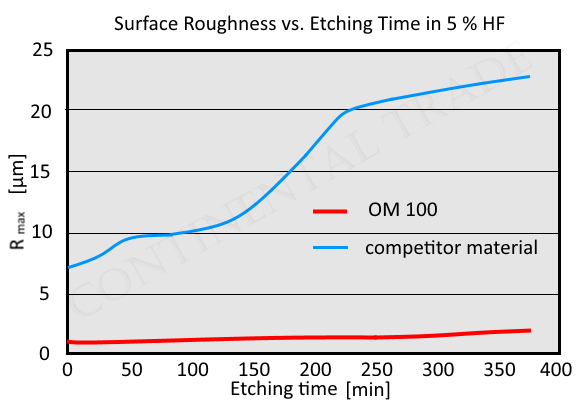Quartz glass
It is a glass with a very high content of pure silica (SiO2 ≥ 99.9%) abstracted eg. with quartzites and rock crystals. It is resistant to water and strong acids (excluding hydrofluoric acid) and low resistance (as compared with other types of glass) to alkali. Quartz glass has a high melting point and a low coefficient of thermal expansion, which makes it resistant to sudden changes in temperature (thermal shock resistance). Transmits ultraviolet and infrared light. The scope and level of transmittance is dependent on the additives used in smelting.
Depending on the technological process (melt process) are distinguished by:
- natural quartz - thanks to a low content of impurities and trace elements, natural quartz is suitable for operation at high temperature (> 1000°C), and for applications requiring optical transmittance from the ultraviolet to the infrared.
- synthetic quartz - by the use of pyrolysis in the glass melt obtained homogeneous with good transmittance for ultraviolet radiation (as from 170 nm)
An important parameter in choosing the right kind of quartz glass is a transmittance of electromagnetic radiation. Various types of glass permeable to different degrees various ranges of radiation. The figure below shows the distribution of electromagnetic radiation spectrum ranges and subranges in respect of infrared and ultraviolet.
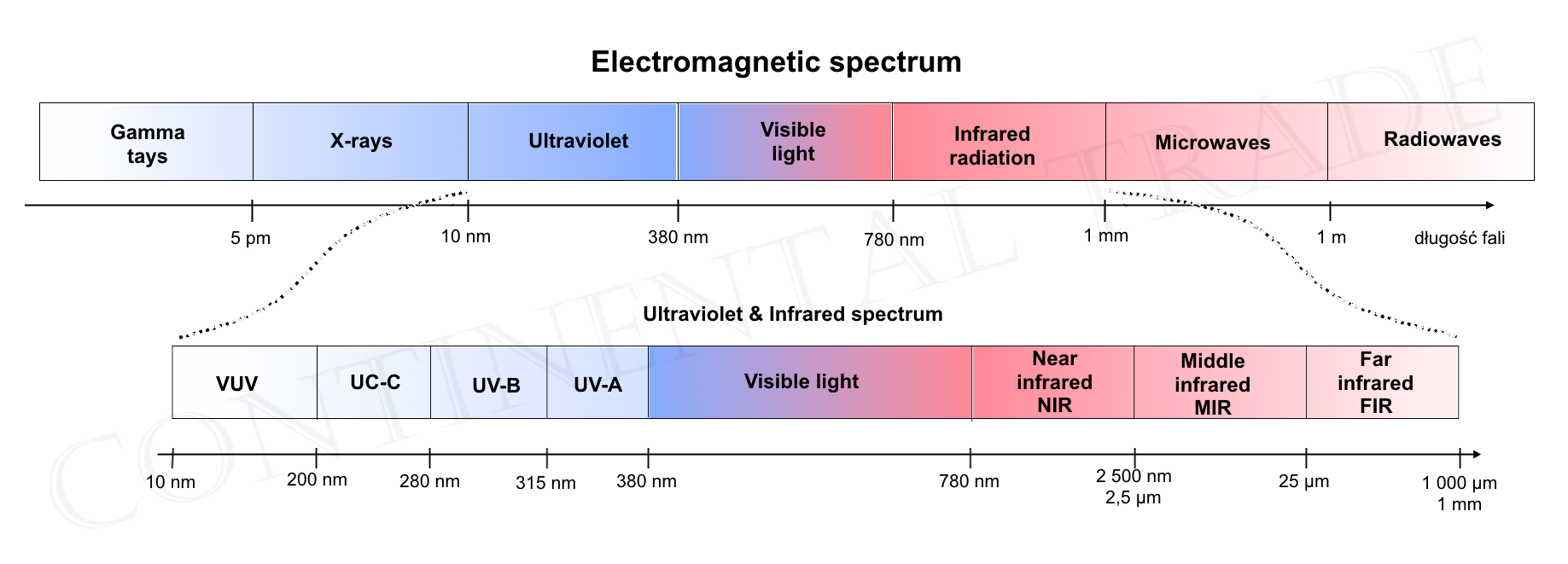
Depending on the application, should be selected quartz glass generate ozone (VUV region) or acting bactericidal (UV-C region). Near and medium infrared (NIR regions, MIR) are used for heating and drying. Quartz glass, depending on the type, well permeable to radiation in the range of UV-C to MIR (from approx. 100 nm to 3 500 nm). Figure transmittance of electromagnetic radiation (light) is illustrated below for each of this type of quartz glass.
Properties comparison of glasses JGS family
Quartz glasses JGS-1, JGS-2 and JGS-3 differ mainly in the scope of the transmitted electromagnetic radial:
- JGS-1 glass - passes ultraviolet radiation, practically free of bubbles and inclusions range of applications starting from 170 nm to 2500 nm; does not pass the range 2600 - 2800 nm, suppresses infrared radiation,
- JGS-2 glass - good transmittance of visible and ultraviolet light; may contain small amounts of bubbles and inclusions, is a good material for use in the band from 220 nm to 2500 nm range; does not pass the range 2600 - 2800 nm
- JGS-3 glass - passes infrared radiation well, good material for applications in the range 260 nm to 3500 nm.
Physical and chemical properties of these of glasses are similar and are shown below.
Properties of quartz glasses JGS-1, JGS-2 and JGS-3:
Density and thermal expansion coefficient
| Glass type | Density [g/cm3] | Thermal expansion coefficient(α×10ˉ7/℃) | ||||||
|---|---|---|---|---|---|---|---|---|
| 0℃ | 50℃ | 100℃ | 300℃ | 500℃ | 800℃ | 1000℃ | ||
| JGS-1 | 2.201 | 3.9 | 4.8 | 5.15 | 6.12 | 5.4 | 4.65 | 4.26 |
| JGS-2 | 2.203 | 3.9 | 4.8 | 5.15 | 6.12 | 5.4 | 4.65 | 4.26 |
| JGS-3 | 2.203 | 3.9 | 4.8 | 5.15 | 6.12 | 5.4 | 4.65 | 4.26 |
Other parameters:
| Parameter | Value |
|---|---|
| Purity | SiO2:99.95-99.99% |
| Modulus of elasticity (Young’s) | 72 GPa |
| Poisson’s ratio | 0,14 - 0,17 |
| Mohs hardness | 5,5 - 6,5 |
| Compressive strength | 1 100 N/mm2 |
| Tensile strength | 48 N/mm2 |
| Flexural strength | 67 N/mm2 |
| Thermal conductivity | 1,4 W/(m K) |
| Specific heat | 0,670 kJ/(kg K) |
| Annealing point | 1215 °C |
| Softening point | 1683 °C |
| Thermal shock ΔT | >1 400 °C |
| Max. working temperature: | |
| - long term | 1 100 °C |
| - temporary | 1 300 °C |
Optical properties
Refractive index
| Range code/ glass type | ∩g | ∩F | ∩e | ∩d | ∩D | ∩c |
|---|---|---|---|---|---|---|
| JGS-1 | 1.46669 | 1.46314 | 1.46007 | 1.45847 | 1.45637 | |
| JGS-2 | 1.46679 | 1.46324 | 1.46021 | 1.45857 | 1.45646 | |
| JGS-3 | 1.46679 | 1.46324 | 1.46021 | 1.45857 | 1.45646 |
Chemical properties
Hydrolytic resistance
Acc. ISO 719 (@ 98 °C): class HGB 1
Acc. ISO 720 (@ 121 °C): class HGA 1
Alkali resistance
Acc. DIN 52 322 (acc. ISO 695): class A2
Acid resistance
Acc. DIN 12 116: class 1
Electrical properties
Resistivity
@ 20°C = 1 x 1016 Ω cm
@ 400°C = 1 x 108 Ω cm
@ 800°C = 6,3 x 104 Ω cm
@1200°C = 1,3 x 103 Ω cm
Dielectric properties
@25° C i 1 MHz:
dielectric constant εr=3,7 - 3,9
loss tangent tgδ =1 x10-4
There are many different names used in quartz glass name terminology. In the document below (ready for download) we discuss some of them and give you the most important information about properties and areas of application of glasses from the JGS-x group.
Quartz glass JGS-1
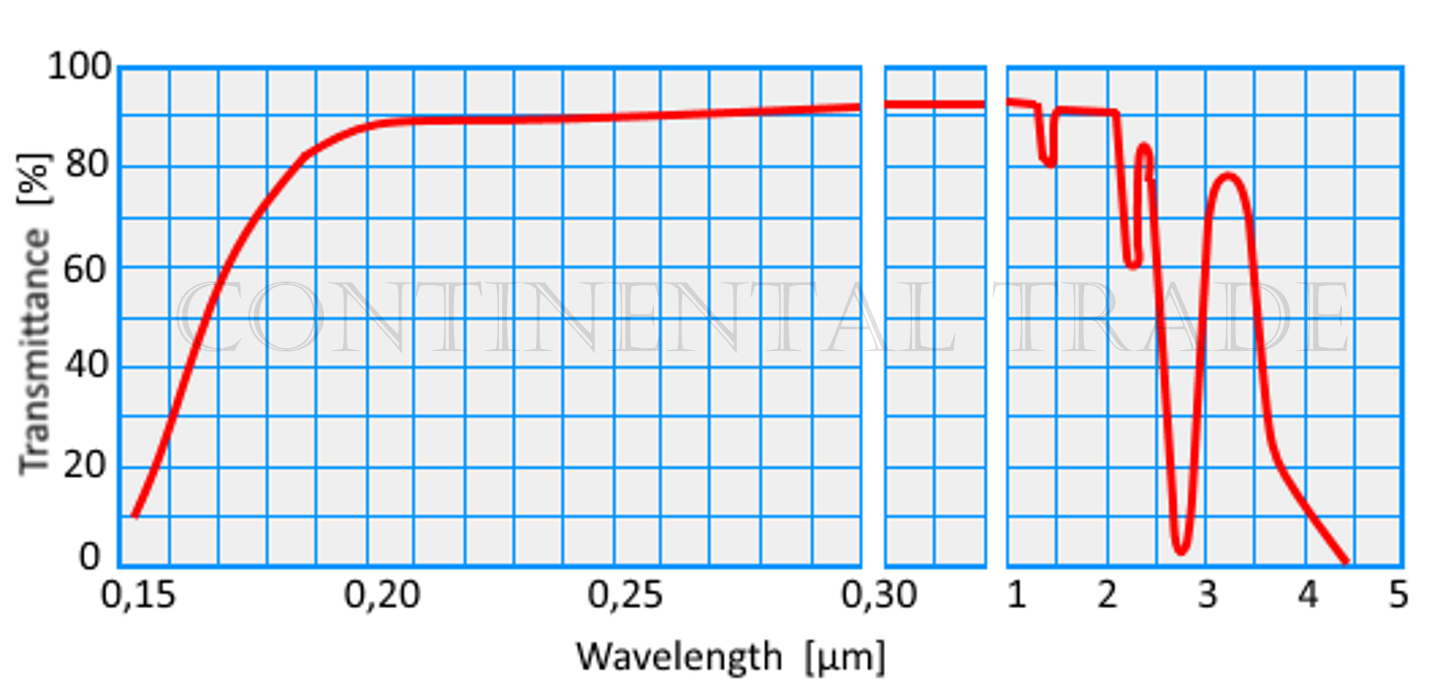 JGS-1 (Synthetic Quartz Silica) glass is equivalent to Suprasil 1 and 2 (Heraeus), Spectrosil A and B (Saint-Gobain) and Corning 7940 (Corning), Dynasil Dynasil 1100 and 4100 (Dynasil). It is made of synthetic silica of very high purity (SiO2 over 99.9999%). Colorless quartz glass combines a low coefficient of thermal expansion and good optical properties and excellent transmittance in the ultraviolet. JGS1 glass is transparent to ultraviolet and visible light. Contains dopant OH groups causing low transmittance in infrared range of in 1.4 µm, 2.2 µm, 2.7 µm.
JGS-1 (Synthetic Quartz Silica) glass is equivalent to Suprasil 1 and 2 (Heraeus), Spectrosil A and B (Saint-Gobain) and Corning 7940 (Corning), Dynasil Dynasil 1100 and 4100 (Dynasil). It is made of synthetic silica of very high purity (SiO2 over 99.9999%). Colorless quartz glass combines a low coefficient of thermal expansion and good optical properties and excellent transmittance in the ultraviolet. JGS1 glass is transparent to ultraviolet and visible light. Contains dopant OH groups causing low transmittance in infrared range of in 1.4 µm, 2.2 µm, 2.7 µm.
JGS-1 glass is used in the wavelength range from deep ultraviolet light through a range of visible light (laser lenses, windows, prisms, solar cells, etc.). This glass is practically free from bubbles and inclusions.
Quartz glass JGS-2
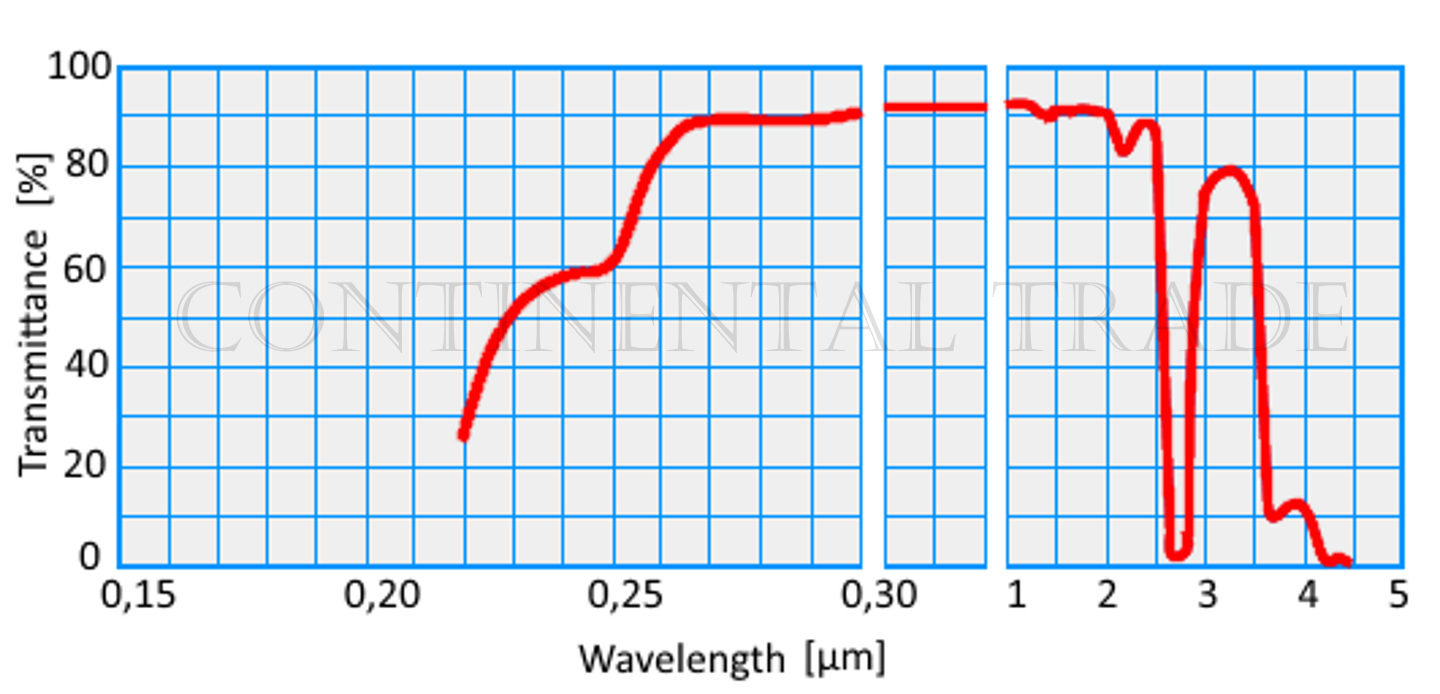 Quartz glass JGS-2 (Fused Quartz) is equivalent to: GE214, Homosil glasses 1, 2 and 3 (Heraeus), Dynasil 1000, 4000, 5000 and 6000 (Dynasil). It is made of natural silica (sand, crystals) of high purity (SiO2 over 99.99%). Provides good transmittance for visible light and ultraviolet. It is a good material for use in the band from 220 nm to 2500 nm. Physical and chemical properties are similar to the glass JGS-1. It may contain a small amount of bubbles and inclusions. JGS-2 glass is used in applications where the main criterion is the ability to work at high temperatures and resistance to thermal shock. The most common applications are: optics, high-temperature and high-pressure equipment, glass viewing window, microscope slides, laboratory equipment.
Quartz glass JGS-2 (Fused Quartz) is equivalent to: GE214, Homosil glasses 1, 2 and 3 (Heraeus), Dynasil 1000, 4000, 5000 and 6000 (Dynasil). It is made of natural silica (sand, crystals) of high purity (SiO2 over 99.99%). Provides good transmittance for visible light and ultraviolet. It is a good material for use in the band from 220 nm to 2500 nm. Physical and chemical properties are similar to the glass JGS-1. It may contain a small amount of bubbles and inclusions. JGS-2 glass is used in applications where the main criterion is the ability to work at high temperatures and resistance to thermal shock. The most common applications are: optics, high-temperature and high-pressure equipment, glass viewing window, microscope slides, laboratory equipment.
Quartz glass JGS-3
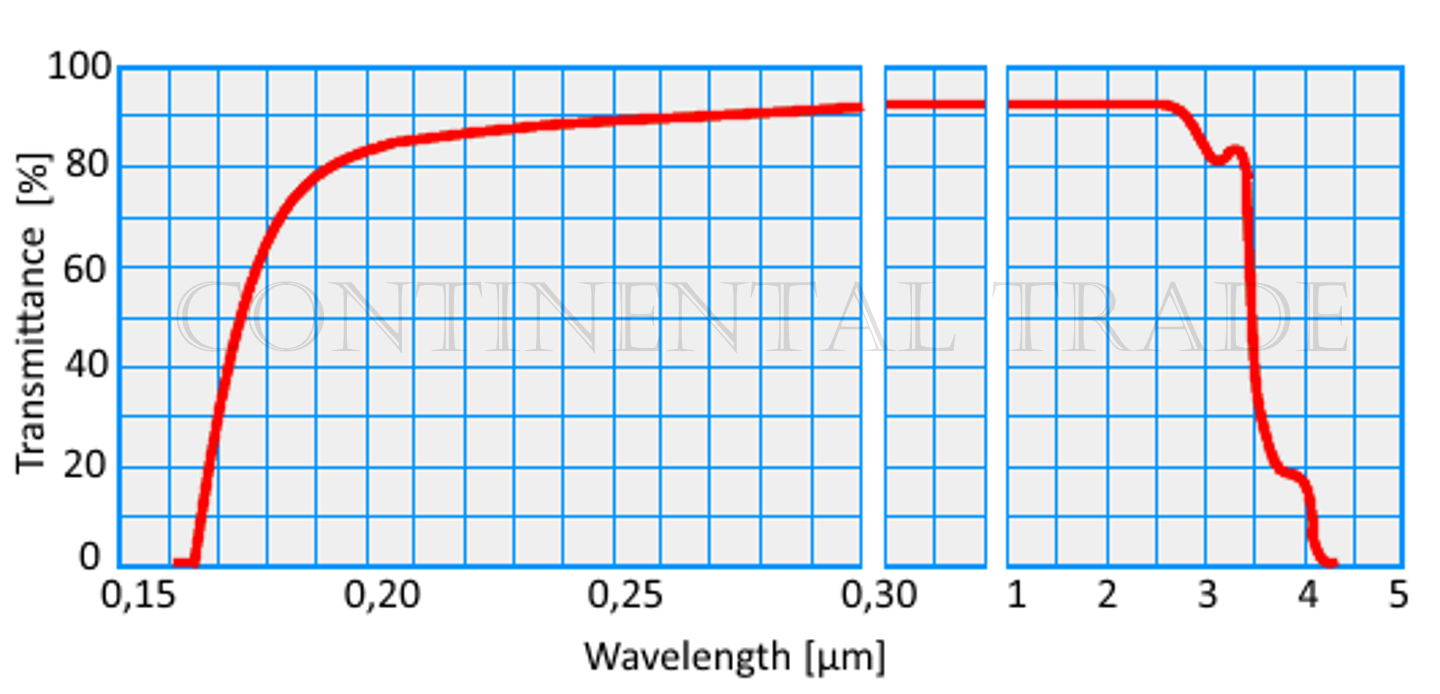 Quartz glass JGS-3 (Infrared Optical Quartz) is the equivalent of a glass Suprasil 300 (Heraeus). It is made of synthetic silica of high purity. It combines excellent physical properties with excellent optical characteristics. It is transparent over a wide band ranging from deep ultraviolet to full infrared. It is a material having excellent light transmittance. Normally used in IR, but also in implementations requiring a broad range of wavelengths from the UV to the IR-d-m.
Quartz glass JGS-3 (Infrared Optical Quartz) is the equivalent of a glass Suprasil 300 (Heraeus). It is made of synthetic silica of high purity. It combines excellent physical properties with excellent optical characteristics. It is transparent over a wide band ranging from deep ultraviolet to full infrared. It is a material having excellent light transmittance. Normally used in IR, but also in implementations requiring a broad range of wavelengths from the UV to the IR-d-m.
Glass JGS-3 is used at wavelengths from 260 nm to 3500 nm.
Products made of JGS-3 quartz are available as plates up to 300x200 mm and a thickness of 1 - 5 mm as well as discs with a diameter of up to 200 mm and a thickness of up to 10 mm. Other dimensions on request.
Milky (Opaque, Satin) Quartz Glass
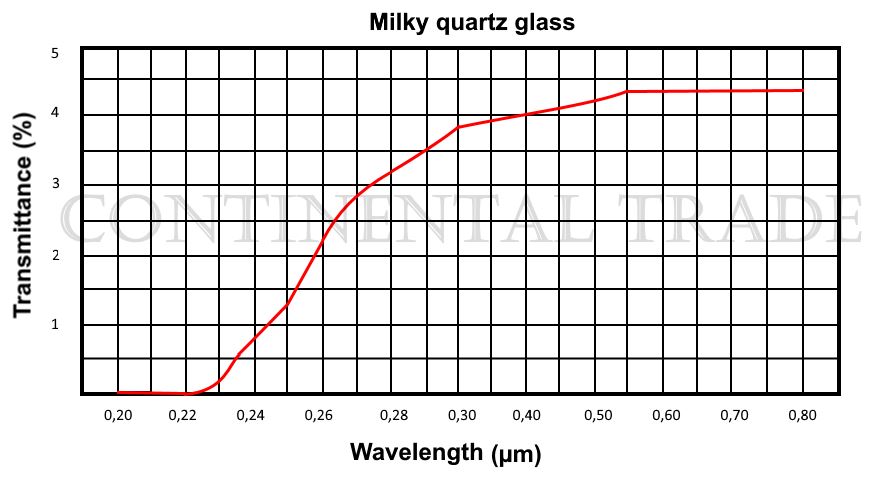 Milky (Opaque, Satin) Quartz Glass JGSM
Milky (Opaque, Satin) Quartz Glass JGSM
The opacity of a quartz glass is obtained by adding the air during the melting process of silica sand. At a temperature of approx. 2000 ° C produced a glassy material with lots of bubbles, causing light scattering and opacity suitable material.
The quality of the material is determined by the uniformity of distribution of bubbles, their size and shape. Many small vesicles (approx. 10 µm) scatter light better than bubbles large and very few (eg. 50 - 150 microns) - giving an opacity effect worse, especially at small thicknesses of material.
Milky quartz, known also as Opaque Quartz Glass or Satin Quartz Glass, due to scattering of radiation in the micropores, is a very good thermal insulator, blocks IR, has a microporous structure with a high density and smooth surface. It can be machined at a reasonable cost. It is opaque, it can be used at high temperatures (constant operating temperature up to 1100 ° C) and chemically aggressive environments.
Low porosity of the material allows to obtain properties similar to fused quartz, while the possibility of gas welding without material shrinkage smooth and without joints. It can be combined with a transparent quartz.
If applied flame polishing, the surface micropores disappears (cicatrize), creating a clean, smooth surface. Does not arise the "orange peel" effect. In addition to improving cosmetic appearance, smoother surface allows the use of thin seals in vacuum applications. In addition, reduced porosity increases the resistance of the material of hydrofluoric acid (HF). Flame smoothed surfaces are smooth, even after long-term HF acid.
|
The advantages of material:
|
Resistance to 5% hydrofluoric acid (HF) |
Specialized applications requiring increased chemical and thermal resistance, high and uniform level of light scattering should be based on the use of materials produced by recognized manufacturers such as Heraus (OM100, RotoSil OFM 70, OFM 370, 970 OFM OSC) or Momentive (GE514, GE544).
While every attempt has been made to verify the source of the information, no responsibility is accepted for accuracy of data.






